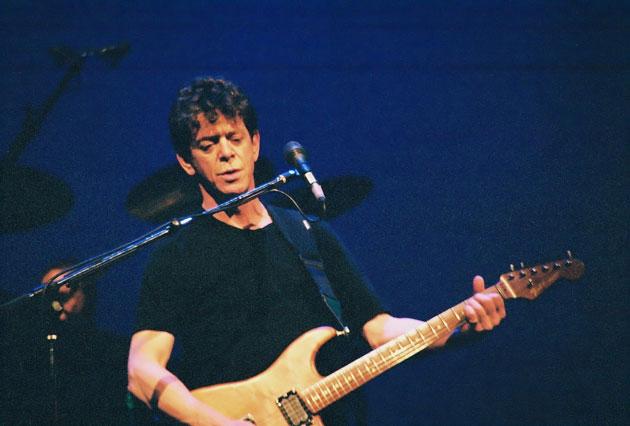
Many people cite the first wave of punk rock as lasting less than two years. An oversimplified timeline would run from the release of the Ramones’ self-titled first album in April of 1976 to the breakup of the Sex Pistols in 1978. In fact, however, these two years represent little more than a snapshot of the time when punk captured a mainstream audience’s attention. Sadly, it is also the time when bands from that era played the most idiomatic style of punk music that was transparently aggressive, willfully antagonistic, and showed a disregard for technique and ability with a guitar approach that focused almost entirely on power chords. This lesson aims to set the record straight: The first wave of punk started in the 1960s, evolved fruitfully during the 1970s, featured clever and inventive guitar playing throughout, and was more of an attitude aimed at originality, rather than stylistic conformity.
The Velvet Underground’s “Ostrich” Tuning
Most music scholars agree that if you want to trace punk’s origins, you need to start with the Velvet Underground. And in many ways, you couldn’t find a more punk sound than Lou Reed’s “ostrich” tuning. Reed named it after his novelty song “The Ostrich,” which he recorded with the Primitives in 1964. Check out the video below to hear Reed’s song. The ostrich tuning assigns one note, in two or three octaves, to all the guitar strings.
[embedded content]
In Ex. 1, we have a short riff where all the strings are tuned to D. You achieve this by tuning the 1st, 3rd, 5th, and 6th strings down, tune the 2nd string up, and leaving the 4th string as is. This creates an idiosyncratic droning sound that allows for melodies to be easily played while simultaneously strumming chords that would be impossible to finger in any other way. The Velvet Underground used this tuning to great effect on two songs recorded in 1966, “Venus in Furs” and “All Tomorrow’s Parties” (the latter accompanied by the distinctive percussion style of drummer Moe Tucker).
The Guitarists of Hell
Richard Hell that is. Hell, born Richard Lester Meyers, sang and played bass for several proto-punk bands in the early 1970s and wrote one of the genre’s classic songs, “Blank Generation.” He also surrounded himself with several interesting and innovative guitarists. On his most well-known record, Blank Generation, he was joined by guitarists Robert Quine and Ivan Julian, whose playing comes off as a punk version of James Brown’s rhythm section mixed with some of the angular, single-note lines like King Crimson’s Robert Fripp. For prime examples of these unexpected juxtapositions have a listen to “Who Says? (It’s Good to Be Alive)” and “Liars Beware.” You can check out some takes on this style in Ex. 2 and Ex. 3.
Television
Prior to fronting the Voidoids, Richard Hell cofounded the band Television with drummer Billy Ficca and guitarists Tom Verlaine and Richard Lloyd. Hell left the group before they recorded their seminal Marquee Moon. In Hell’s absence, Verlaine went on to write songs that are as much Steely Dan as Velvet Underground. And boy could Verlaine and Lloyd play some weird guitar! Just check out the 1975 recording “Little Johnny Jewel (Part 1 & 2),” which features the sound of strings pushed against pickups, heavily muted arrhythmic chromatic single-note lines, non-bluesy quarter-step bends, jagged, staccato chord stabs, and pick scrapes with rhythmic definition. Ex. 4 demonstrates these techniques over a static bass vamp.
Reggae and the Clash
Although the Clash was one of the many bands guilty of using the power chord clichés of 1976, they did so with panache, as well as with solid songwriting and vocal ability. And they evolved! By the time they released their third album, London Calling, the Clash had incorporated reggae, rockabilly, and ska into their unique blend of punk.
Ex. 5 demonstrates a distinctive take on reggae rhythm guitar, inspired by what Joe Strummer and Mick Jones delivered in “London Calling.” In this example, Guitar 1 adds some punchy accents over a very straight, non-reggae bass part, while Guitar 2 plays a traditional reggae rhythm, but with a more aggressive tone and attack. This recognition and understanding of other musical traditions, coupled with a complete disregard for playing them conventionally, is a hallmark of punk.
The Slits
The last guitarist I’d like to look at is the all-too-often overlooked and uncelebrated Viv Albertine from the Slits. The Slits were a pioneering all-female band whose 1979 album Cut features many punk songs with a reggae influence. (For a different—and much more aggressive—take on many of the songs on Cut, I recommend searching out live performances and early demos of songs on that record). Ex. 6 demonstrates an approach akin to Albertine’s scratchy rhythms on tracks like “Instant Hit,” “Shoplifting,” and “Ping Pong Affair.”
If you’ve gotten this far and are thinking “None of this sounds like punk to me!” Good. Maybe you can take away more than just some guitar parts! Punk isn’t a sound, it’s an attitude and approach to music, and power chords will only get you part way there.